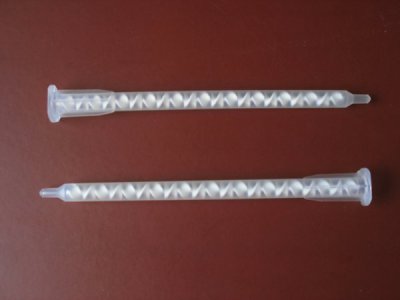Tom,
I would first try enlarging the hole in your nozzle, it's size is not so critical as the .040" hole in the mixing block. You might even try removing the nozzle. Once you've done that, you can use more air flow to carry the small droplets to the work.
What is happening right now is that the air starts to carry the droplets at the mixing block as it is travelling at a velocity high enough to do so. Once the air/coolant stream hits the large inner diameter of your flex hose, the velocity is greatly reduced and the fluid droplets drop out of the slower moving air. Once the liquid forms a large enough 'puddle' in the flex hose, the air pushes all of it out at once. You also might be opening your fluid needle valve too far due to the perception that there is no coolant coming through.
The original design called for a straight nozzle that is relatively short in length, and small enough in diameter to keep the air velocity high enough to still carry the droplets, but not so high that the droplets become atomized, thus not creating a fog in the room. The flex hose you are using may be what is causing the problem.
I made a prototype that worked reasonably well, but it was a bit bulky. The mixing block was too large, as were the needle valves that I used in the first design. The design in the drawings is a smaller version of that prototype, and I still need to build one of the smaller ones. The needle valves are sensitive, especially if they are overly large, but the sensitivity is not as bad at lower pressures. You should only need about 20 PSI at max, maybe a hair bit more, but probably less in most cases. You are looking for air volume, not pressure. A higher volume stream, at lower pressures, can carry tiny droplets of fluid in the air stream. Air will provide most of the cooling, aided by the cooling effect of a tiny bit of fluid.
In use, you should turn on the air first. Get a nice flow going at a lower pressure, but not so much flow that it gets real noisy. Next, just crack the fluid valve open a tiny bit while holding a finger out ahead of the nozzle. When the fluid starts coming, you may not see it, but you will feel it as the temperature of the air stream will drop sharply. If you watch closely you will see that your finger is starting to get wet, but not dripping wet. That is all you need. One canister of coolant should last for several hours, as in all day or more. Granted, a heavier milling job will need a bit more coolant, but you will be surprised at just how little it really takes.
Fiddle with your modifications a bit, then come back and let us know how you've done. Feel free to tell us what works and what doesn't, and don't be afraid to critique my design if you find a flaw with it, even if it is only a personal preference. I am going to be out of town for a couple of weeks, but will check back here when I return.
Wermie,
Thanks for your explanation and suggestions. I've got a kitchen remodel in progress so may not be able to get back to the coolant system for a few days. But I will post what I did and the end results. Enjoy your two weeks away, I'm assuming it's vacation.
Tom S

